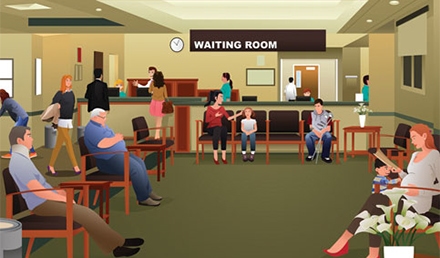Q. We are afraid of getting denials for using unspecified ICD-10-CM [International Classification of Diseases, 10th Revision, Clinical Modification] codes. In an urgent care center, we sometimes will see a particular patient only one time for minor illnesses and injuries, and follow-up with their primary-care physician is always advised. Do you have any advice on documenting to get claims paid? A. Within ICD-10-CM, you may select codes defined as “Not Otherwise Specified” (NOS). Generally, this should …
Read MoreThe Most Frequent Disposition of Cases at U.S. Urgent Care Centers in 2014
Data from the 2014 Urgent Care Chart Survey of 1,778,075 blinded visits by patients to more than 800 different urgent care clinics, conducted by the Journal of Urgent Care Medicine, reveal that the most frequent disposition of cases at U.S. urgent care centers in 2014 was provision of follow-up care as needed. The survey’s methodology and data abstraction forms were initially designed in 2008 by researcher Robin M. Weinick, PhD, then an assistant professor at …
Read MoreTravel Immunizations
Q. What is the best way to code for and bill patients who come in because they are planning to travel out of the country and need to know what immunizations they should have before traveling? We advise them on preventive measures to take in relation to where they are traveling, provide literature if appropriate, and even try to find health-care facilities close to where they will be staying while abroad. I know we can …
Read More
Urgent Care Solutions for Health Systems to Improve Access
Urgent message: Although the Patient Protection and Affordable Care Act expands health insurance coverage to millions of previously uninsured, many of the newly insured grapple with lack of access to quality, on-demand care, which leads to increased emergency department use. Urgent care provides a solution for health systems to expand access, reduce the number of unnecessary emergency department visits, and realize the goal of integrated population health management. MICHAEL F. BOYLE, MD, MBA, FACEP Introduction …
Read MoreHow to Recognize and Handle Potentially Litigious Patients
Angela T. Burnette, JD Urgent message: Although any urgent care center could potentially face litigation at any time, the risks of being sued can be reduced by focusing on provider behaviors that build strong relationships with patients, by recognizing patient behaviors that may increase the odds of litigation, and by having a plan for handling dissatisfied patients. Lawsuits do not discriminate. They are filed against all types of health-care providers—new or experienced, group practice or …
Read MoreTop 3 Rapid Tests Performed at U.S. Urgent Care Centers in 2014
Data from the 2014 Urgent Care Chart Survey of 1,778,075 blinded visits by patients to more than 800 different urgent care clinics, conducted by the Journal of Urgent Care Medicine, reveal that the top 3 rapid tests performed at U.S. urgent care centers in 2014 were as follows, in descending order: • Rapid group A Streptococcus test—15.59 million tests • Rapid influenza test—13.91 million tests • Rapid chlamydia test—0.92 million tests The survey’s methodology and …
Read MoreProtecting Patient Privacy in the Cloud
K Royal, JD, CIPP/E, CIPP/US Urgent message: The shift in medical practice from written charts to integrated digital platforms has dramatically increased the visibility, size, and magnitude of health-care information breaches. There are specific steps urgent care operators should take with vendors to protect patient information in this new technological environment. The news makes it seem that data breaches occur on a fairly regular basis. The Ponemon Institute even named 2014 as the year of …
Read More
Improving the Patient Experience by Thinking Differently About Waiting
Urgent message: Attracting and retaining urgent care patients entails more than reducing the total duration of patient waits. It also requires understanding and managing patient expectations and perceptions of waiting. MICHAEL BURKE, MBA, and GARRETT BOMBA, MD People often respond irrationally in waiting situations. How else can we explain the fact that people are routinely more satisfied with a clearly explained 30-minute wait than with an uncertain 20-minute wait? It is not rational, but it …
Read MoreTop 3 Blood Tests Performed at U.S. Urgent Care Centers in 2014
Data from the 2014 Urgent Care Chart Survey of 1,778,075 blinded visits by patients to more than 800 different urgent care clinics, conducted by the Journal of Urgent Care Medicine, reveal that the top 3 blood tests performed at U.S. urgent care centers in 2014 were as follows, in descending order: • Comprehensive metabolic panel—3.15 million tests • Glucose level—1.23 million tests • Thyroid-stimulating hormone level—1.19 million tests The survey’s methodology and data abstraction forms …
Read MoreOpen Fracture Treatment Versus Closed Fracture Treatment
Q. We had a patient come in with an open fracture of the distal interphalangeal joint of the right index and middle fingers, ICD-9 [International Classification of Diseases, 9th Revision, Clinical Modification] code 816.12. The provider set and splinted them both. Can I bill procedure code 26765 (“Open treatment of distal phalangeal fracture, finger or thumb, includes internal fixation, when performed, each”) twice? A. A diagnosis of open fracture means that the skin has been …
Read More